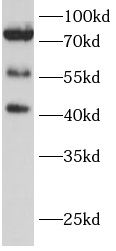Products
MAVS antibody
Category:
| Synonyms: | CARD adapter inducing interferon beta antibody, Interferon beta promoter stimulator protein 1 antibody, Cardif antibody, Putative NF-kappa-B-activating protein 031N antibody, Virus-induced-signaling adapter antibody | ||
| Catalogue No.: | FNab10248 | Reactivity: | Human, Mouse, Rat |
| Host: | Rabbit | Tested Application: | ELISA, WB, IHC |
| Clonality: | polyclonal | Isotype: | IgG |
- SPECIFICATIONS
- Product Name
- MAVS antibody
- Catalogue No.
- FNab10248
- Size
- 100μg
- Form
- liquid
- Purification
- Immunogen affinity purified
- Purity
- ≥95% as determined by SDS-PAGE
- Clonality
- polyclonal
- Isotype
- IgG
- Storage
- PBS with 0.02% sodium azide and 50% glycerol pH 7.3, -20℃ for 12 months(Avoid repeated freeze / thaw cycles.)
Immunogen
- Immunogen
- mitochondrial antiviral signaling protein
- Alternative Names
- CARD adapter inducing interferon beta antibody, Interferon beta promoter stimulator protein 1 antibody, Cardif antibody, Putative NF-kappa-B-activating protein 031N antibody, Virus-induced-signaling adapter antibody
- UniProt ID
- Q7Z434
- Observed MW
- 40kDa,56kDa,70kDa
Application
- Tested Applications
- ELISA, WB, IHC
- Recommended dilution
- WB: 1:500-1:2000;IHC: 1:50-1:500
Validated Images
 rat kidney were subjected to SDS PAGE followed by western blot with FNab10248(MAVS antibody) at dilution of 1:1000
rat kidney were subjected to SDS PAGE followed by western blot with FNab10248(MAVS antibody) at dilution of 1:1000
 Immunohistochemistry of paraffin-embedded mouse brain tissue slide using FNab10248(MAVS Antibody) at dilution of 1:100
Immunohistochemistry of paraffin-embedded mouse brain tissue slide using FNab10248(MAVS Antibody) at dilution of 1:100
- Background
- Required for innate immune defense against viruses. Acts downstream of DDX58/RIG-I and IFIH1/MDA5, which detect intracellular dsRNA produced during viral replication, to coordinate pathways leading to the activation of NF-kappa-B, IRF3 and IRF7, and to the subsequent induction of antiviral cytokines such as IFN-beta and RANTES(CCL5). Peroxisomal and mitochondrial MAVS act sequentially to create an antiviral cellular state. Upon viral infection, peroxisomal MAVS induces the rapid interferon-independent expression of defense factors that provide short-term protection, whereas mitochondrial MAVS activates an interferon-dependent signaling pathway with delayed kinetics, which amplifies and stabilizes the antiviral response. May activate the same pathways following detection of extracellular dsRNA by TLR3. May protect cells from apoptosis.It can undergoe phosphorylation on multiple sites and ubiquitination, which may together cause the molecular weight migrate to about 70 kDa despite the predicated 57 kDa.



